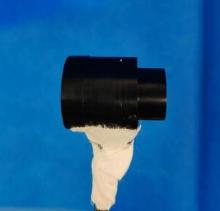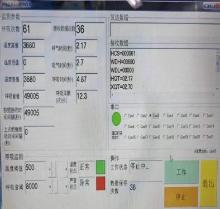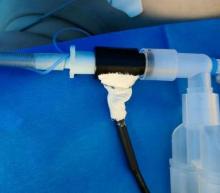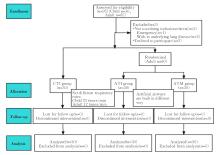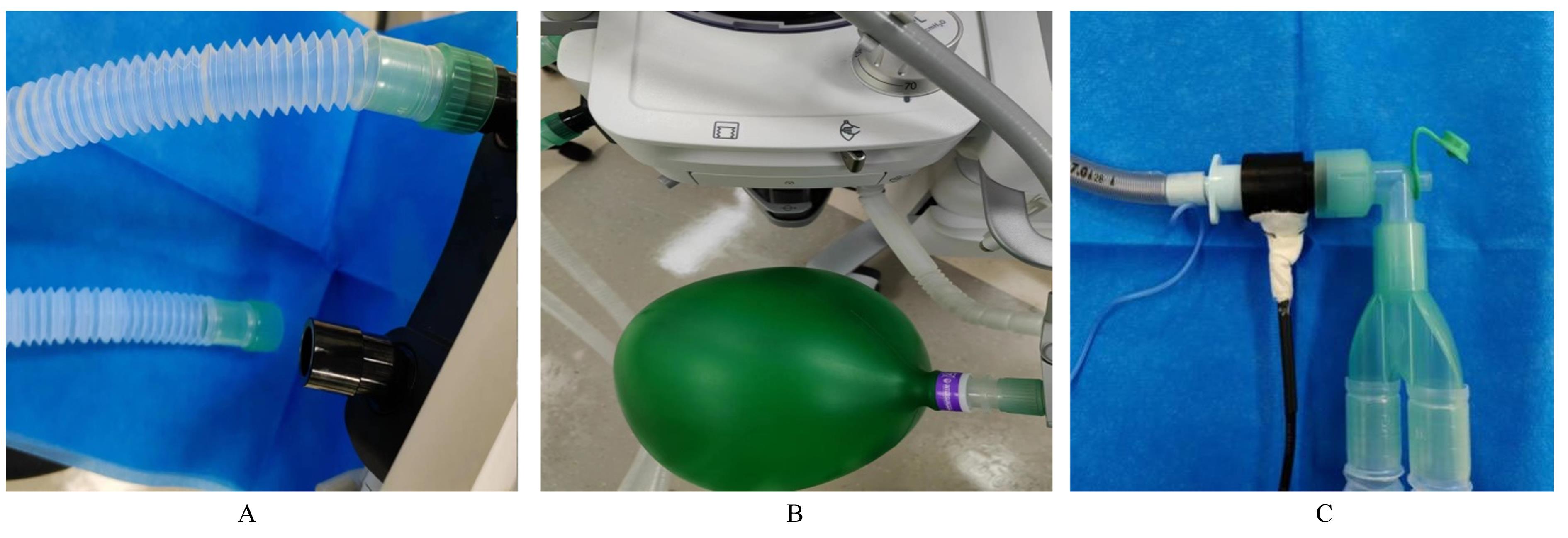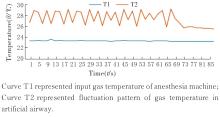Journal of Jilin University(Medicine Edition) ›› 2024, Vol. 50 ›› Issue (4): 1123-1129.doi: 10.13481/j.1671-587X.20240427
• Clinical medicine • Previous Articles Next Articles
Feasibility and efficacy of controlled respiratory persistence monitor in clinical application
Junjie FENG,Chang LU,Shengquan CHENG,Xiao ZHANG,Xufang SUN( )
)
- Department of Anesthesiology,Second Hospital,Jilin University,Changchun 130022,China
-
Received:2023-09-08Online:2024-07-28Published:2024-08-01 -
Contact:Xufang SUN E-mail:xufang@jlu.edu.cn
CLC Number:
- R443.8
Cite this article
Junjie FENG,Chang LU,Shengquan CHENG,Xiao ZHANG,Xufang SUN. Feasibility and efficacy of controlled respiratory persistence monitor in clinical application[J].Journal of Jilin University(Medicine Edition), 2024, 50(4): 1123-1129.
share this article
Tab.1
RR and frequencies set by anesthesia machine of patients in three groups within 60 s detected by conrolled respiratory persistence monitor"
| Group | RR detected by monitor [M(P25,P75)] | Frequency set by anesthesia machine | Z | P |
|---|---|---|---|---|
| CTI | 25.00(25.00,25.00) | 25 | -0.460 | 0.646 |
| ATI | 12.00(12.00,12.00) | 12 | -1.755 | 0.079 |
| ALM | 12.00(12.00,12.00) | 12 | -1.572 | 0.110 |
Tab.2
Start time of alarm of controlled respiratory persistence monitors in various groups during simulating three forms of respiratory persistence change"
| Group | Start time of alarm | ||
|---|---|---|---|
| Disconnection of breathing circuit | Failure to switch from manual to mechanical control | Slow air leakage in breathing circuit | |
| CTI | 7.739±0.344* | 9.223±0.523* | 16.409±0.462 |
| ATI | 15.120±1.285* | 18.428±0.995* | 33.137±0.980 |
| ALM | 15.295±0.568* | 18.126±0.902* | 33.306±1.082 |
| *P<0.05 compared with slow air leakage in breathing circuit. | |||
| 1 | 柯 宏, 梅丽君, 杨品玉. 麻醉中呼吸功能监测管理的重要性[J]. 中国现代药物应用, 2009, 3(15): 184-185. |
| 2 | GAUCHER A, FRASCA D, MIMOZ O, et al. Accuracy of respiratory rate monitoring by capnometry using the Capnomask(R) in extubated patients receiving supplemental oxygen after surgery[J]. Br J Anaesth, 2012, 108(2): 316-320. |
| 3 | 金双燕, 祁海鸥, 周大春. 呼气末二氧化碳分压监测在麻醉复苏室中的应用[J]. 中华护理杂志, 2015,50(4): 498-499. |
| 4 | BRANSON R D, MANNHEIMER P D. Forehead oximetry in critically ill patients: the case for a new monitoring site[J].Respir Care Clin N Am,2004,10(3): 359-367. |
| 5 | LEE L A, CAPLAN R A, STEPHENS L S, et al. Postoperative opioid-induced respiratory depression: a closed claims analysis[J].Anesthesiology,2015,122(3): 659-665. |
| 6 | VÁRADY P, MICSIK T, BENEDEK S, et al. A novel method for the detection of apnea and hypopnea events in respiration signals[J]. IEEE Trans Biomed Eng, 2002, 49(9): 936-942. |
| 7 | 蔡晓岚, 刘洪英, 范献良, 等. 儿童阻塞性睡眠呼吸暂停低通气综合征的诊断[J]. 中华耳鼻咽喉科杂志, 2003, 38(3): 161-165. |
| 8 | 欧阳顺林, 郑佩霞, 褚玉敏, 等. 便携式多导睡眠呼吸监测在成人阻塞性睡眠呼吸暂停低通气综合征诊断中的应用[J]. 中国耳鼻咽喉颅底外科杂志, 2012, 18(2): 111-113. |
| 9 | MA X X, ZHANG S X, ZOU P K, et al. Paper-based humidity sensor for respiratory monitoring[J]. Materials, 2022, 15(18): 6447. |
| 10 | MARJANOVIC N, MIMOZ O, GUENEZAN J. An easy and accurate respiratory rate monitor is necessary[J].J Clin Monit Comput,2020,34(2):221-222. |
| 11 | CRETIKOS M A, BELLOMO R, HILLMAN K,et al. Respiratory rate: the neglected vital sign[J]. Med J Aust, 2008, 188(11): 657-659. |
| 12 | HAKIMI N, SHAHBAKHTI M, HORSCHIG J M,et al.Respiratory rate extraction from neonatal near-infrared spectroscopy signals[J]. Sensors (Basel), 2023, 23(9): 4487. |
| 13 | ADDISON P S, ANTUNES A, MONTGOMERY D, et al. Robust non-contact monitoring of respiratory rate using a depth camera[J]. J Clin Monit Comput, 2023, 37(4): 1003-1010. |
| 14 | NUNZIA M, EMILIANO S, SERGIO S,et al. Breathing chest wall kinematics assessment through a single digital camera: A feasibility study[J].Sensors (Basel, Switzerland),2023,23(15):6960. |
| 15 | YOO W J, JANG K W, SEO J K, et al.Development of respiration sensors using plasticoptical fiber for respiratory monitoring inside MRI system[J]. J Opt Soc Korea, 2010, 14(3): 235-239. |
| 16 | BAI Y E, XIE E, LI Q,et al. Fabrication and characterization of yarn-based temperature sensor for respiratory monitoring[J]. J Donghua Univ Engl Ed, 2022, 39(6): 527-532. |
| 17 | MANSOUR E, VISHINKIN R, RIHET S, et al. Measurement of temperature and relative humidity in exhaled breath[J]. Sens Actuat B Chem, 2020, 304: 127371. |
| 18 | HÖPPE P. Temperatures of expired air under varying climate conditions[J].Int J Biometeorol, 1981, 25(2): 127-132. |
| 19 | ALLAN D. Eyes wide shut: improving physiologic monitoring during mechanical ventilation[J].Pediatr Crit Care Med, 2016, 17(12): 1180-1181. |
| 20 | NEJI B, FERKO N, GHANDOUR R, et al. Micro-fabricated RTD based sensor for breathing analysis and monitoring[J]. Sensors, 2021, 21(1): 318. |
| 21 | CHIUMELLO D. Is humidification always necessary during noninvasive ventilation in the hospital?[J]. Respir Care, 2010, 55(7): 950. |
| 22 | PLEIL J D, ARIEL GEER WALLACE M, DAVIS M D,et al. The physics of human breathing: flow, timing, volume, and pressure parameters for normal, ondemand, and ventilator respiration[J]. J Breath Res, 2021, 15(4): 042002. |
| 23 | FIORILLO A S, CRITELLO C D, PULLANO S A. Theory, technology and applications of piezoresistive sensors: a review[J]. Sens Actuat A Phys, 2018, 281: 156-175. |
| 24 | ZHAO C, LIU D, XU G X, et al. Recent advances in fiber optic sensors for respiratory monitoring[J]. SSRN J, 2022,72:103000. |
| 25 | 杨玉志. 医疗设备报警提示系统的探讨[J]. 中国医疗设备, 2010, 25(7): 20-22. |
| 26 | QUATRARA B, COFFMAN J, JENKINS T, et al. The effect of respiratory rate and ingestion of hot and cold beverages on the accuracy of oral temperatures measured by electronic thermometers[J]. Medsurg Nurs, 2007, 16(2): 105-108, 100. |
| 27 | 佘守章. 围术期呼吸功能监测的进展[J]. 临床麻醉学杂志, 2007, 23(7): 588-590. |
| 28 | 郑嘉玲, 吕 杰, 刘 杨, 等. 麻醉机不良事件相关数据分析[J]. 中国医学装备, 2020, 17(1): 55-58. |
| 29 | 程子雯, 王清秀. 睡眠觉醒环路与全身麻醉后苏醒延迟神经机制的研究进展[J]. 同济大学学报(医学版),2023, 44(3): 438-445. |
| [1] | Yuhang DONG,Haixia GAO,Xiaobin CUI,Feng LI. Energy metabolite analysis on ESCC based on LC-MS/MS multi-response monitoring technology [J]. Journal of Jilin University(Medicine Edition), 2023, 49(5): 1253-1261. |
| [2] | ZHANG Ning, PIAO Meihua, WANG Meikun, LIU Nan, FENG Chunsheng. Eye injury after non-ocular surgery in patients underwent general anesthesia: A report of 2 cases and literature review [J]. Journal of Jilin University(Medicine Edition), 2019, 45(01): 156-159. |
| [3] | DONG Xuemei, WANG Lijuan, SHEN Hong, ZHAO Yan, ZHANG Xiujuan, QIAO Yue, CAI Hanqing. Application of insulin dose adjustment in blood glucose control in patients with type 2 diabetes treated by insulin pump [J]. Journal of Jilin University(Medicine Edition), 2018, 44(06): 1280-1285. |
| [4] | WANG Xu, JI Mingxin, HAO Mingyue, JIA Lina, YANG Tongwei. Influence of methylprednisolone in respiratory mechanics parameters in elderly patients with general anesthesia and its clinical significance [J]. Journal of Jilin University Medicine Edition, 2017, 43(02): 361-364. |
| [5] | REN Jingchao, ZHANG Guanghui, HAO Pengfei, CHEN Lu, FAN Zhongyuan, WANG Kuan, YANG Haiyan, DUAN Guangcai. Hygiene condition of microbial contamination of central water supply in rural areas of Henan province and their influencing factors [J]. Journal of Jilin University Medicine Edition, 2016, 42(06): 1230-1236. |
| [6] | WANG Bin, SONG Hongmei, YU Mingxin, LI Yunqian. Application of neural electrophysiological monitoring in facial nerve microvascular decompression [J]. Journal of Jilin University Medicine Edition, 2015, 41(06): 1264-1269. |
| [7] | CHEN Bing,LIU Hao-chuan,CHEN Peng,ZHAO Guo-qing,GAO Ming. Influence of dexmedetomidine in peri-extubation haemodynamics and analepsia process of patients with general anesthesia for total hip replacement [J]. Journal of Jilin University Medicine Edition, 2013, 39(4): 804-809. |
| [8] | LI Xin,CUI Yong-sheng,LIU Bai-nan,LI Yi. Effect of low dose cyclophosphamide on function of CD4+CD25+Treg cells of mice with Lewis lung cancer [J]. J4, 2008, 34(5): 733-736. |
